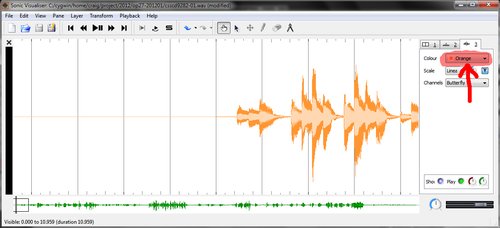Op27: Difference between revisions
No edit summary |
|||
| Line 16: | Line 16: | ||
[[File:op27-pluginmenu.png|500px|thumb|center|Verify that Mazurka Plugins have been installed.]] | [[File:op27-pluginmenu.png|500px|thumb|center|Verify that Mazurka Plugins have been installed.]] | ||
== Using the Mazurka Plugins == | |||
Here is a step-by-step description of how I load an audio file and add plugin data on to various layers in Sonic Visualiser. | |||
=== Load an audio file === | |||
Load and audio file by going to <b>File → Open...</b> (or type {{keypress|Ctrl|O}} as a keyboard shortcut to open a file). Select an audio file from the file browsing window which appears. If the audio file is in stereo, the display in Sonic Visualiser after loading will look like this: | |||
[[File:op27-firstload.png|500px|thumb|center|View immediatly after a file has been loaded.]] | |||
Since stereo information will not be important, switch to a monophonic display. To do this, click on the <i>Waveform</i> tab at the far right of the main display pane. For this particular example, it is the third tab which you can also open with the keyboard shortcut {{keypress|Alt|3}}. When the waveform options are display, select <i>Butterfly</i> or <i>Mean</i> instead of <i>Separate</i>. Refer to the red arrow in the following image which points to the change: | |||
[[File:op27-butterfly.png|500px|thumb|center|View after <i>Butterfly</i> display is selected.]] | |||
Also select the <i>Normalize Visible Area</i> button which is just above and to the left of the <i>Butterfly</i> text in the Waveform options panel. This setting will automatically scale up quiet waveforms and scale down loud waveforms so that the full range of the display pane shows the waveform amplitude. See the following figure which has the red arrow pointing to the normalization button: | |||
[[File:op27-normalize.png|500px|thumb|center|View after <i>Butterfly</i> display is selected.]] | |||
An optional setup is to change the waveform color to orange. I do this to minimize the waveform display so that plugin analysis data is more visible: | |||
[[File:op27-orangewaveform.png|500px|thumb|center|View after <i>Butterfly</i> display is selected.]] | |||
Revision as of 07:36, 17 January 2012
This page describes data entry and processing for performances of Webern's Piano Variations, Op. 27.
Install Software
Download Sonic Visualiser
Download Sonic Visualiser (current version 1.9) from http://sonicvisualiser.org/download.html for either Windows or Linux. In Windows, unzip the downloaded program installation file and store the executable in any location on your computer.
Download Mazurka Plugings
Next, create the directory C:\Program Files\Vamp Plugins. On a 64-bit Windows computer, instead create the directory C:\Program Files (x86)\Vamp Plugins. Then download the file http://sv.mazurka.org.uk/download/windows/mazurka-plugins.dll from the webpage http://sv.mazurka.org.uk/download and save the dll file in the newly created directory.
Verify Installation
Double-click on the executable for Sonic Visualsier. Then go Transform → Analysis by Maker → The Mazurka Project. You should see a list of plugin options as shown in the plugin below (click three times on the image for full size):
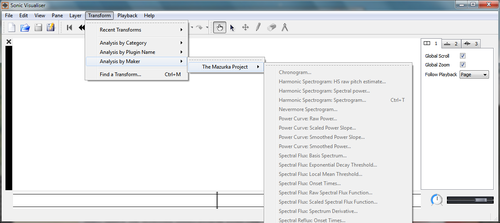
Using the Mazurka Plugins
Here is a step-by-step description of how I load an audio file and add plugin data on to various layers in Sonic Visualiser.
Load an audio file
Load and audio file by going to File → Open... (or type Ctrl+O as a keyboard shortcut to open a file). Select an audio file from the file browsing window which appears. If the audio file is in stereo, the display in Sonic Visualiser after loading will look like this:
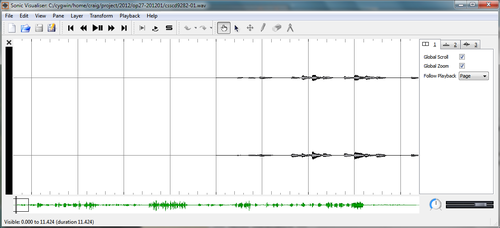
Since stereo information will not be important, switch to a monophonic display. To do this, click on the Waveform tab at the far right of the main display pane. For this particular example, it is the third tab which you can also open with the keyboard shortcut Alt+3. When the waveform options are display, select Butterfly or Mean instead of Separate. Refer to the red arrow in the following image which points to the change:
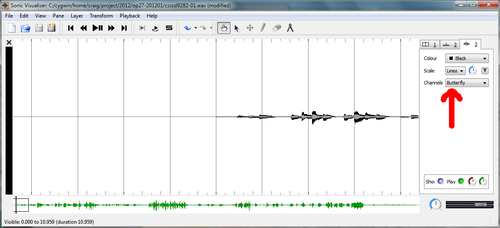
Also select the Normalize Visible Area button which is just above and to the left of the Butterfly text in the Waveform options panel. This setting will automatically scale up quiet waveforms and scale down loud waveforms so that the full range of the display pane shows the waveform amplitude. See the following figure which has the red arrow pointing to the normalization button:
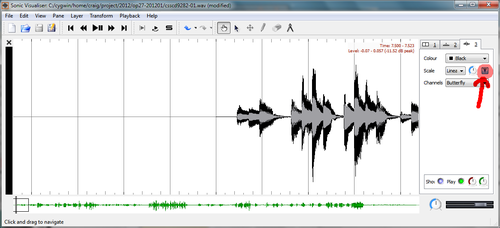
An optional setup is to change the waveform color to orange. I do this to minimize the waveform display so that plugin analysis data is more visible:
